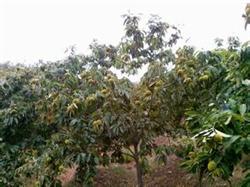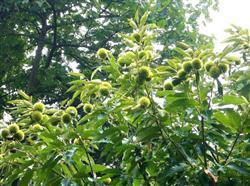Water-saving technology of Chinese chestnut in mountainous area

1. The tree plate is covered with grass. Tree plate grass mulching is an economical, convenient and labor-saving technical measure, which can make full use of the weeds growing on the edge of the hillside and the straw after harvest. It can not only store water and preserve soil moisture, but also increase the content of soil organic matter and enhance soil ventilation and permeability. Specific approach is: weeds or harvested corn straw, bean vines and other mulch that can be used nearby, cover the grass from the inside to the outside along the tree plate, with a thickness of 10 to 15 centimeters, and sprinkle a small amount of soil on it after covering to prevent wind blowing and fire. Supplement and cover grass once a year and turn it deeply every 3-4 years to make it rot and increase soil nutrients. two。 The tree disk is covered with film. Plastic film mulching on tree plate is one of the key measures to improve the survival rate of mountain chestnut afforestation in recent years. Plastic film mulching can not only increase the ground temperature and promote root growth, but also reduce soil water evaporation. The covering time is that it can be carried out after the Chinese chestnut afforestation operation is completed. The covered area varies with the age of the tree, at least not lower than the tree plate, and compacted with soil all around after mulching to prevent it from being blown away by the wind. 3. Dig a hole under the crown. Digging holes under the canopy is suitable for most engineering site preparation of Chinese chestnut forest, as well as building chestnut forest on steep hillsides. The specific method is: take the tree trunk as the center, carry on the triangular radial diffusion around, and sort out several small pits under the tree plate. The size and shape of the pit vary with the topography, the depth and width of the pit is about 30 cm, and the number depends on the size of the canopy. The coverage of the pit can be extended to 2-3 meters outside the canopy, which can effectively control soil erosion and protect water, soil and fertilizer. 4. The hole stores fertilizer and water. The operation of fertilizer and water storage in acupoint is simple and practical. Through the experiment, the yield is increased significantly. The specific method is: before the tree body germinates, dig a hole along the crown, the diameter of the pit is 30 cm 40 cm, the depth is 40 cm 50 cm, put the pre-bound grass such as wheat straw or weeds into the hole vertically, and use the mixed fine soil, add a small amount of long-acting compound fertilizer, backfill to the hole around the grass, firm and level the ground, the grass covers the top soil 2 cm 3 cm, watering 4 kg, covering the hole with plastic film, and pressing the soil all around. Make it low in the middle and four weeks high in the shape of the bottom of the pot, a small hole is opened in the center, and the watering and fertilization after film mulching are carried out on the hole, usually pressed with clods to prevent evaporation.
- Prev

There are four ways to save water in mountain chestnut
1. Deep ploughing and soil improvement, heavy application of organic fertilizer Due to frequent loss of management in mountain chestnut gardens, serious soil erosion and extremely low soil fertility, measures should be taken to improve soil fertility. Deep ploughing and soil improvement immediately after fruit picking in that year. Second, after picking fruit, topdressing outside the root after picking fruit, timely topdressing outside the root can ensure that the leaves fall off in time,...
- Next

How to control diseases and insect pests of Chinese chestnut
Chestnut in Anhui Province is mainly distributed in the mountainous areas of southeastern and western Anhui, and the Jianghuai hilly area has also developed on a large scale since the 1990s. The main chestnut counties (cities) are Jinzhai, Huoshan, Shucheng, Yuexi, Guangde, Ningguo, Taihu Lake and so on. There are more than 150 kinds of diseases and insect pests that harm Chinese chestnut in our province.
Related
- Moge, come on! The staff of the peasant association in the producing area of cantaloupe were frightened when the crowd gathered.
- Causes and Solutions of low Fruit setting rate of Apple
- Symptoms and control measures of passion fruit virus disease
- Fruit growing lesson: how do apple orchards keep high yields?
- Can you build orchards in the mountains? What are the pros and cons?
- How to manage the coloring period of Crisson grape?
- This paper introduces the processing technology of two kinds of fig products.
- How much is a month for retired teachers in rural areas by 2020?
- How can strawberry planting increase sugar content? We should pay attention to management in many aspects.
- What are the cultivation techniques on how to improve the yield of golden fruit?

